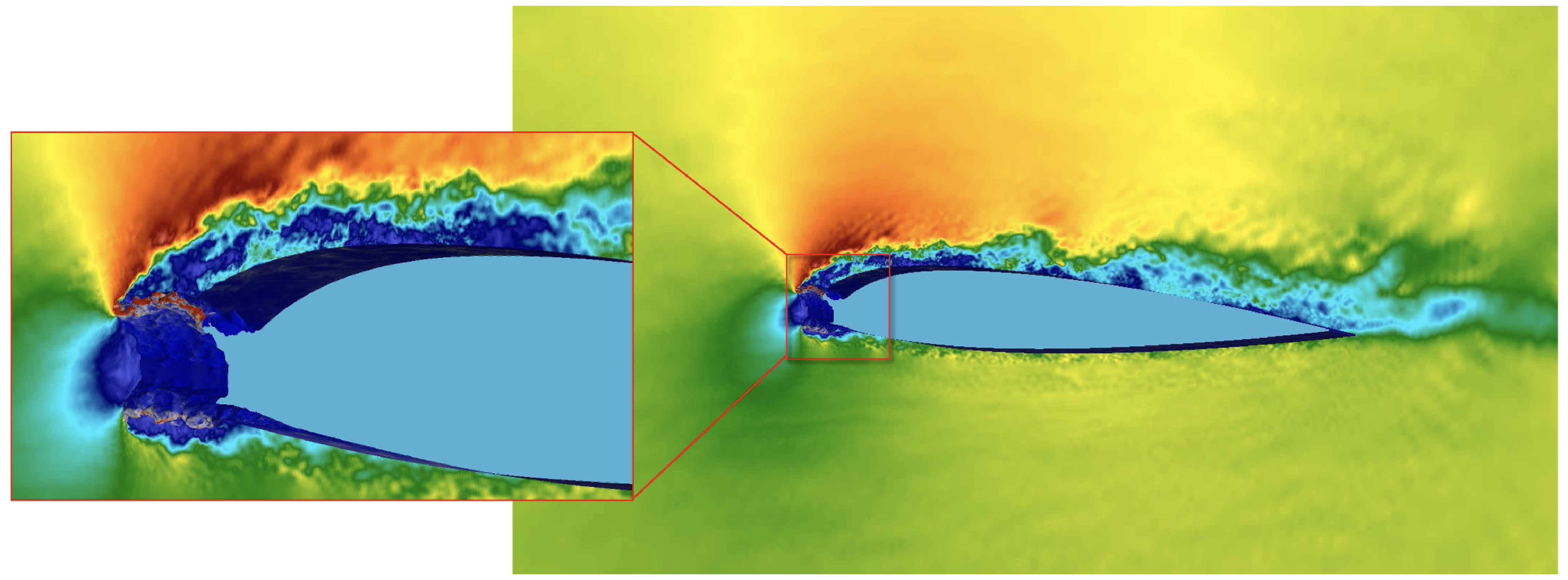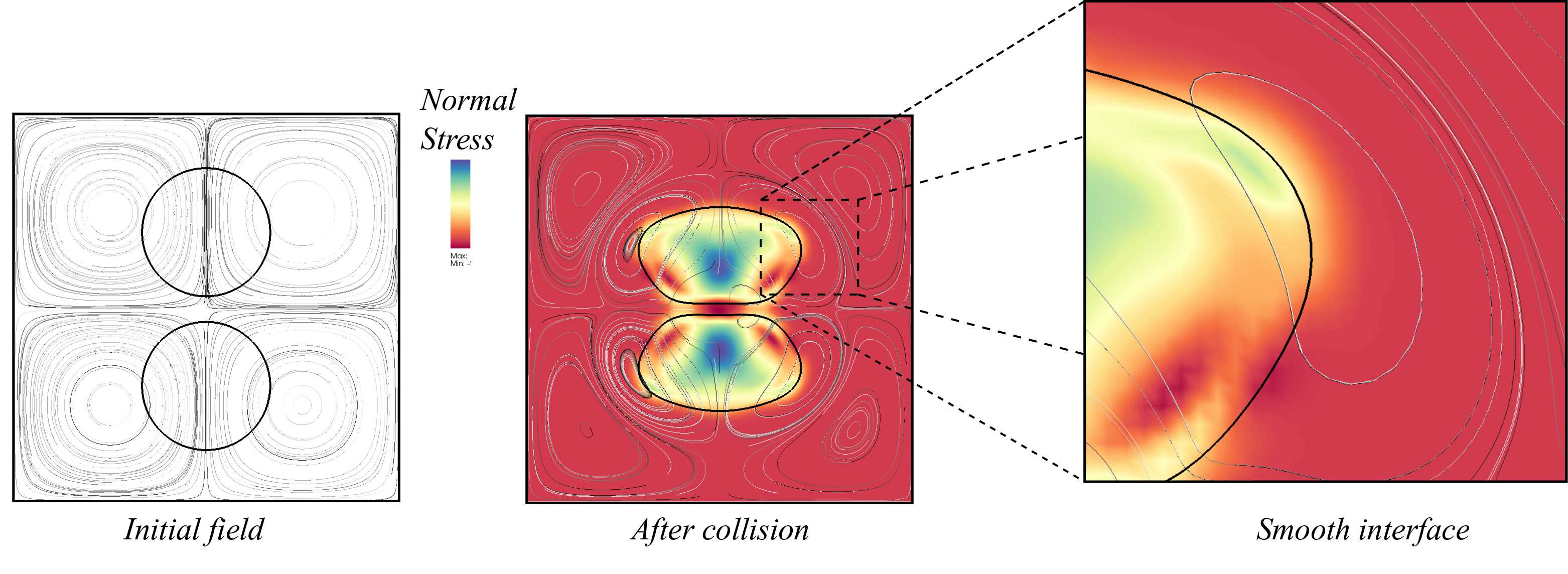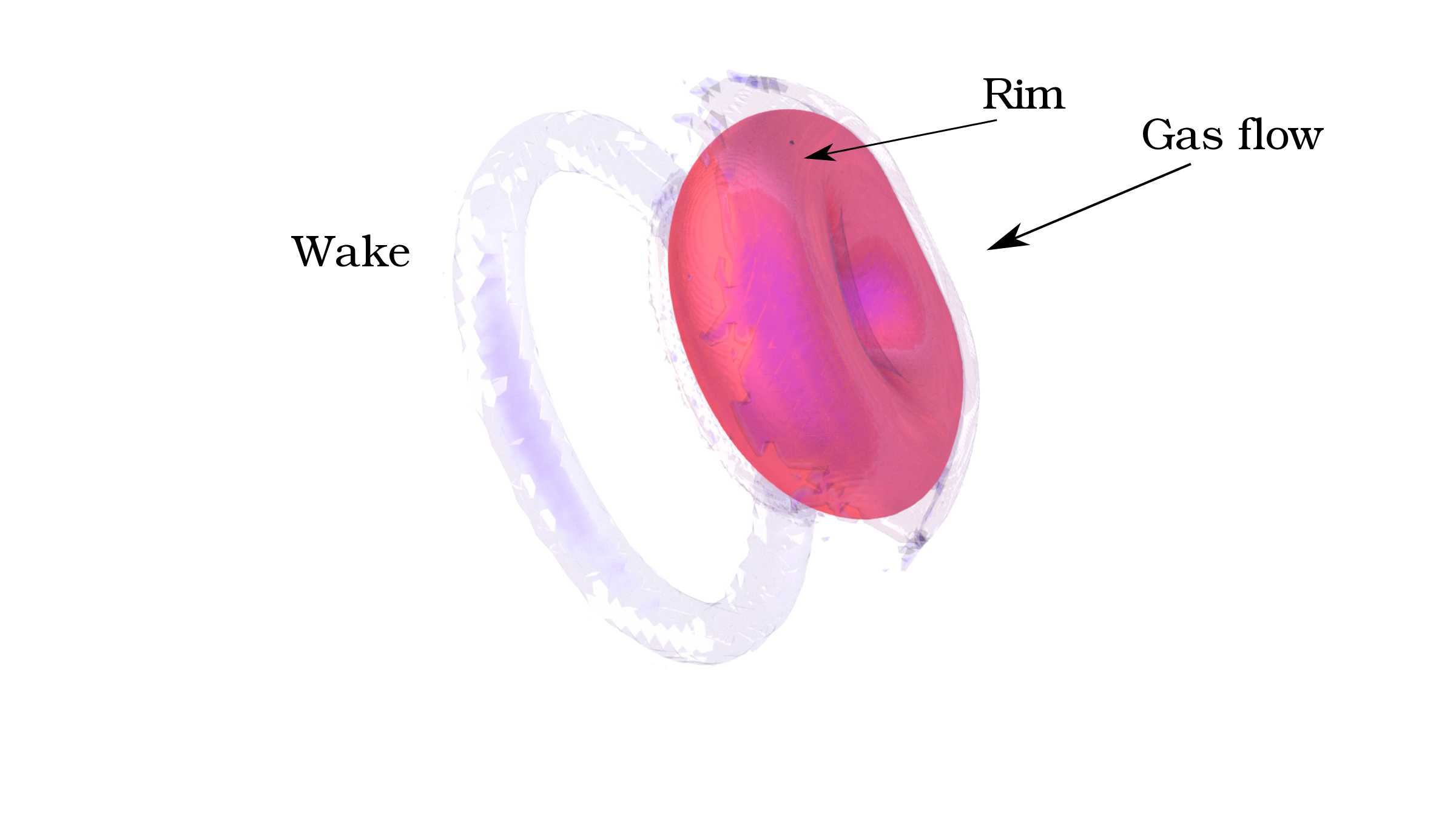Areas
Multiphase flows.
Turbulent flows.
Compressible flows.
Aerodynamics.
Fluid-structure interaction.
Computational fluid dynamics.
Artificial intelligence.
High-performance computing and quantum computing.
Research Projects
1. Ice accretion, aerodynamics, and roughness modeling
Icing is freezing of supercooled water droplets on the aircraft lifting surfaces and wind turbines at or below freezing temperatures. Modeling and prediction of ice accretion are
important primarily for aircraft safety and also for the design of efficient wind turbines.
In this ongoing work, we are interested in (a) modeling the ice accretion process, and (b) modeling the aerodynamic impact of roughness due to icing.
Previous modeling attempts have been limited due to the use of lower-fidelity modeling approaches. We are performing higher-fidelity wall-modeled large-eddy simulations (WMLES) of NACA23012 airfoil and CRM65 swept wing with realistic rough iced geometries. Furthermore, we are also developing subgrid roughness models to accurately simulate rime ice geometries that involve fine scale roughness features that are not viable with the current WMLES tools. We are also using higher-fidelity Lagrangian point-particle modeling, subgrid modeling of freezing within the large-eddy simulation framework for modeling ice accretion prediction.
I am mentoring Brett Bornhoft and Lucy Brown (both Ph.D. students of Prof. Moin) as part of this project. This project is funded by Boeing Co.

Flow over NACA23012 airfoil at 5° angle of attack with horn ice.
Droplet impingement on 30P30N airfoil at 4° angle of attack.
Reference:
Jain, S, S; Bornhoft, B; Bose, S, T; Moin, P 'Large-eddy simulation of droplet impingement using a Lagrangian particle model', International Conference on Icing of Aircraft, Engines, and Structures, 2023.
Bornhoft, B; Jain, S, S; Goc, K; Bose, S, T; Moin, P 'Wall-modeled LES of laser-scanned rime, glaze, and horn ice shapes', Center for Turbulence Research, Annual Research Briefs, 2022. (Report)
2. Scalar and surfactant transport modeling for two-phase flows
In two-phase flows, modeling transport of passive and active scalars are important. These scalars could represent charged ions in
two-phase electrochemical systems, soluble surfactants, dissolved salts, and CO2 in ocean. The scalar quantities typically have disparate properties in two phases,
which results in effective confinement of the scalar quantities in one of the phases, in the time scales
of interest. This confinement of the scalars leads to the formation of sharp gradients of the scalar
concentration values at the interface, presenting a serious challenge for its numerical simulations. To
overcome this challenge, we proposed a new consistent model for the transport of scalars in two-phase flows that (a) maintains the positivity property of the
scalar concentration field, a physical realizability requirement for the simulation of scalars, when the
proposed criterion is satisfied, and (b) prevents artificial numerical
leakage of the scalar at the interface. The model has been shown to be robust and accurate to perform numerical simulations in a wide range of two-phase flow regimes, spanning laminar to turbulent flows.
This model was further extended to include interfacial transfer terms to model heat and mass transfer across the interface.
Similarly, we also developed a model for transport of insoluble surfactants where the scalar is now confined to only the interface region. This model was also shown to be robust and accurate.

Scalar transport in a droplet-laden channel flow.

CO2 dissolution in a breaking wave.
Reference:
Jain, S, S, Mani, A 'A computational model for transport of immiscible scalars in two-phase flows', Journal of Computational Physics, 476, 111843, 2023. (DOI)(PDF)
Mirjalili, S, Jain, S, S, Mani, A 'A computational model for interfacial heat and mass transfer in two-phase flows using a phase field method', International Journal of Heat and Mass Transfer, 197, 123326, 2022. (DOI)(PDF)
3. Diffuse-interface methods for two-phase flows
Multiphase flows have a wide range of applications in natural and engineering processes. Yet, numerical simulations of multiphase flows are challenging due to the difficulty in handling discontinuities in quantities across the interface. The idea behind diffuse-interface methods is to artificially increase the thickness of the interface such that the gradients across the interface can be resolved on an Eulerian grid. However, diffuse-interface methods have always known to be less accurate compared to sharp-interface approaches due to the need for large number of grid points across the interface.
I developed an accurate conservative diffuse-interface/phase-field (ACDI) model for the simulation of multiphase flows. This method conserves the mass of each of the phases and results in bounded transport of the volume fraction while maintaining the interface thickness on the order of only 1-to-2 grid points. This method results in significant improvement in the accuracy of interface shape and surface tension forces over the commonly used second-order conservative phase-field method. The capability of the ACDI model to maintain such sharp interfaces without the need for any special geometric treatment, unlike the sharp-interface methods, makes it a highly attractive interface-capturing method for accurate simulations of multiphase flows at an affordable cost.
Next, for the simulation of compressible multiphase flows, a five-equation model that consists of transport equations for the volume fraction, the mass of each phase, momentum, and total energy is typically used. Starting from this baseline five-equation model, we developed modifications to this model in such a way that the resulting system of equations can be discretized using a non-dissipative central scheme that is suitable for the simulation of turbulent flows and acoustics. The resulting model is conservative, scalable, and maintains a constant interface thickness throughout the simulation. Furthermore, for stable and accurate numerical simulations of compressible flows, particularly at high Reynolds numbers (Re), it is known that a discrete entropy condition needs to be satisfied in addition to the discrete conservation of kinetic energy. We developed a numerical flux formulation for the five-equation model that satisfies this condition (a KEEP scheme) and showed that this formulation results in stable numerical simulations of compressible turbulent multiphase flows at high Re.
This project was supported by a Franklin P. and Carolin M. Johnson Fellowship and the Office of Naval Research, USA.

Rayleigh-Taylor instability induced flow at Atwood number of 0.15 and Reynolds number of 1000.
Reference:
Jain, S, S 'Accurate conservative phase-field method for simulation of two-phase flows', Journal of Computational Physics, 469, 111529, 2022. (DOI)(PDF)Jain, S, S, Moin, P 'A kinetic energy--and entropy-preserving scheme for compressible two-phase flows', Journal of Computational Physics, 464, 111307, 2022. (DOI)(PDF)
Jain, S, S, Mani, A, Moin, P 'A conservative diffuse-interface method for compressible two-phase flows', Journal of Computational Physics, vol 418, 109606, 2020. (DOI)(PDF)
4. Eulerian formulations for fluid-solid and solid-solid interactions
Historically, a Lagrangian framework has been preferred for modeling solids and fluid-structure interaction problems in the stiff limit, due to the accuracy of the method. But for modeling highly-deforming solids, this approach is known to be cumbersome and expensive.
In this study an improved reference-map technique (RMT) was developed for the simulation of hyperelastic solids in a fluid on an Eulerian grid. Multiple improvements for RMT was proposed,
which allowed simulations without artificial viscosity in solid regions while maintaining numerical robustness and completely eliminated the striations (wrinkling) of the interface that was seen before in previous studies. The improved method was also shown to be cost effective and more accurate compared to the previous Eulerian methods.
In another study, we developed diffuse-interface framework for modeling the interface between deforming elastic-plastic solids by proposing consistent corrections in the kinematic transport equations that track the deformation of the solid. Using this novel formulation, we successfully simulated a Richtmyer-Meshkov instability between Copper-Aluminum interface.
This was supported by a Franklin P. and Carolin M. Johnson graduate Fellowship and the Office of Naval Research, USA.

Collision of two hyperelastic solids placed in a Taylor-Green vortex.
Reference:
Jain, S, S, Kamrin, K, Mani, A, 'A conservative and non-dissipative Eulerian formulation for the simulation of soft solids in fluids', Journal of Computational Physics, vol 117, pp. 25-41, 2019. (DOI)(PDF)
Jain, S, S; Adler, M; West, J; Mani, A; Moin, P; Lele, S 'Assessment of diffuse-interface methods for compressible multiphase fluid flows and elastic-plastic deformation in solids', Journal of Computational Physics, 475, 111866, 2023. (DOI)(PDF)
5. Atomization of a liquid jet in swirling gas crossflow
In this study, we performed detailed numerical simulations of a liquid jet breakup in high-speed gaseous crossflow to study the effect of swirl on the breakup characteristics of the jet.
The liquid jet is injected radially outwards from a central tube to a confined annular space into the gas crossflow as shown in the Figure below.
Simulations were performed using a geometric volume-of-fluid (VOF) method where the interface was resolved and adaptive mesh refinement (AMR) was used to reduce the cost. The use of AMR made it possible for the first time to resolve most of the important length scales in the problem, which resulted in no pile-up at small scales in the drop size distribution (a numerical artifact that is seen in all previous simulations).
Spray characteristics such as drop size distribution, velocity of the drops, shape factor, and column breakup length were analyzed in detail and correlations were proposed for jet trajectory.
Interestingly, we observed significant coalescence of drops downstream in the domain. This behavior has been later verified by other researchers. This has significant implications in understanding and modeling sprays.
This project was funded by Pratt and Whitney, USA.

$Q=20$ and $SN=0$.

$Q=20$ and $SN=0.84$.

Drop size distribution.
6. Secondary breakup of drops
It was previously assumed that the dynamics of secondary breakup of drops was dependent only on the Weber number (We); however, the experimental observations from different studies showed a variation in breakup behavior at the same We. So, this prompted us to carefully look at the effect of other parameters.
Using numerical simulations and scaling analysis, we studied the effect of density ratio, Reynolds number, and viscosity ratio on drop morphology and the breakup mechanism. We also studied in detail the role of dynamics of the droplet rim and the Rayleigh-Taylor instability on the surface of the drop that are considered the major mechanisms that are in play for the bag formation process. Finally, we presented a density ratio - Weber number phase plot reflecting the drop behavior at various density ratios and Weber numbers and we showed that the density ratio is a critical parameter that governs the dynamics of droplet deformation and breakup, which explains the discrepencies in experimental observations that could not be explained before. This has huge implications in modeling secondary breakup.

Density ratio = 10, Weber number = 20.

Density ratio = 1000, Weber number = 20.